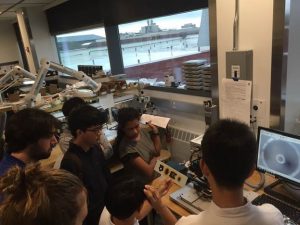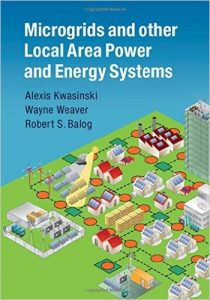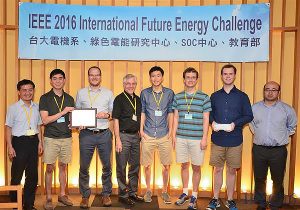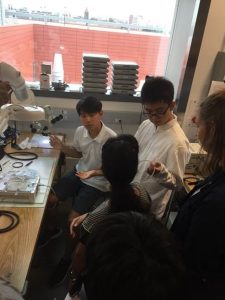Ali Bazzi, PhD 2010 U of I (P. Krein, adviser), Assistant Professor, University of Connecticut, was named IEEE Transportation Electrification eNewsletter Editor-in-Chief. This publication addresses four domains: Terrestrial (land based), Nautical (Ocean, lakes and bodies of water), Aeronautical (Air and Space) and Commercial-Manufacturing. Its main topics are batteries, advanced charging, telematics, systems architectures that include schemes for both external interface (electric utility) and vehicle internal layout, drivetrains, and the connected vehicle.
Olaoluwapo Ajala, Runner-up for the Illinois Innovation Prize
The Illinois Innovation Prize, administered by the Technology Entrepreneur Center in the College of Engineering, is awarded on an annual basis to the most innovative students on campus. Three runners-up for the Illinois Innovation Prize each received $2,500 to further their work. Ajala’s research is focused on energy resource optimization technology (see research summary below). His passion for energy stems from his childhood in Nigeria where the lack of constant power supply creates major obstacles for homes and businesses. Owners have to purchase small, and often inadequate, diesel generators, battery-storage systems, solar photovoltaic systems, and other small-scale power generators to meet their electricity needs. Ajala’s innovation electrically connects homes and businesses within a small geographical area to create stand-alone power systems known as micro grids. The micro-grid concept is a common one, but his technology will allow systems is these areas to be interconnected and for home and business owners to share electricity from various sources.
Zunum Aero – Start-Up to Reinvent Regional Air Travel
A start-up co-founded by the Grainger CEME Associate Director, Kiruba Haran, is trying to reinvent regional air travel. Zunum Aero, the Hummingbird of the Skies*, is based in Kirkland, WA and focused on small regional jets powered with electric propellers. The company has received financial backing from Boeing and JetBlue Technology Ventures, a subsidiary of JetBlue Airways, and is currently in the “build” phase with products expected in the 2020s. The first aircraft introduced into the market will have a ten-fifteen passenger capacity and travel up to 700 miles. By 2030, the start-up aims to have planes flying over 1,000 miles carrying up to fifty passengers. The hybrid-electric aircraft are projected to improve the economics of regional trips with significantly lower operating costs. These small, electric jets will also cut travel times since fewer Transportation Security Administration regulations are enforced on smaller planes. *Zunum is a derivation of tzunuum, the Mayan word for hummingbird. Think small, fast, and quiet!
IEEE/PES/PELS/IAS GaN and Surface-Mount Soldering Workshop
The IEEE/PES/PELS/IAS student group sponsored a GaN and Surface-Mount Soldering Workshop on September 9th attended by fifteen students (four undergrad and eleven grads) to learn the best practices of soldering and laboratory safety. Undergrad student Won Ho, who was mentored over the summer by Chris Barth, led the workshop. Students with little or no previous soldering skills
learned how to solder large discrete components, as well as very small components using the Finetech Machine (see the machine at bottom right in photo below). Everyone left the workshop with new skills. The IEEE/PES/PELS/IAS student group was encouraged to make this an annual event, teaching skills that are foundational for ECE 300- and 400-level classes.
Illini Solar Car
Illini Solar Car is a multidisciplinary team of students who design and build solar cars to race in cross-country solar races like the World Solar Challenge and the American Solar Challenge. These races allow students both to apply their technical knowledge to build a road-worthy car and learn soft skills in managing race logistics, such as raising funds. The team, currently in its third year, aims to compete in the World Solar Challenge this October along with teams from other top universities such as MIT, Stanford University, the University of California- Berkeley, and the University of Michigan. The future goal is to build road-worthy and practical multiple-seater solar cars.
Most of the car’s components are designed and built in-house. These include the maximum power point tracker (98.75% efficient and 10 times lighter than the competition), the battery protection system (for the 20 kg lithium-ion battery pack), the motor controller (controls the 95% efficiency wheel hub motors), the solar array (soldered and encapsulated in the clean room), and the carbon fiber semi-monocoque. These components are integrated and adjusted to make the car efficient, reliable, and lightweight (the car is expected to weigh only 375 lbs.).
Professors Pilawa and Philpott, in Mechanical Engineering, are advising the team composed of more than 50 actively involved students from various departments, such as the Electrical and Computer Engineering, Mechanical Engineering, and Aerospace Engineering. Graduate students Derek Chou and Phuc Huynh (see their research summaries below) are working with the mostly undergraduate team.
This project is sponsored by various companies, including 3M, Siemens, Molex, General Electric, Chevron, and Phillips Chemical; alumni, and on-campus entities, including the University of Illinois Student Sustainability Committee, the ECE Department, and the Grainger Center for Electric Machinery and Electromechanics.
Illini Formula Electric Update
The unveiling of the 2017 Illini Formula Electric (IFE) car was held in March at the Engineering Open House (EOH). Lan Li, vice president of IFE, reported that the team was able to drive and test their car with a great audience. Although they test their car each year at EOH, this year, she noted, they had the best performance by far.
Their car is now “successfully functional and running” with the electrical and mechanical systems mostly complete. Only minor adjustments are needed before they go to Chrysler’s test track on April 7th and 8th, which will be the time to test the car’s full functionality before the Formula Electric competition in June in Lincoln, Nebraska.
The Illini team starte d in 2009 as the Illini Hybrid Racing to participate in the relatively new Formula Hybrid racing competition in New Hampshire. In 2012 the team switched to the Illini Formula Electric, with the goal to build a fully electric vehicle for the 2013 Formula Electric competition in Lincoln, Nebraska. This year’s team is led by fifteen undergraduates. The Grainger CEME has been a team supporter for many years.
d in 2009 as the Illini Hybrid Racing to participate in the relatively new Formula Hybrid racing competition in New Hampshire. In 2012 the team switched to the Illini Formula Electric, with the goal to build a fully electric vehicle for the 2013 Formula Electric competition in Lincoln, Nebraska. This year’s team is led by fifteen undergraduates. The Grainger CEME has been a team supporter for many years.
Three CEME PhD Grads Author Microgrids and other Local Area Power and Energy Systems
CEME PhD grads Alexis Kwasinski (’07) – Associate Professor and R. K. Mellon Faculty Fellow, University of Pittsburgh; Wayne Weaver (’07) – Dave House Associate Professor, Michigan Tech; and Robert S. Balog (’06) – Associate Professor and Director of the Renewable Energy and Advanced Power Electronics Research Laboratory, Texas A&M all earned the PhD degree und er Professor Emeritus Philip Krein and co-authored Microgrids and other Local Area Power and Energy Systems. Published by Cambridge University Press, it came out in hardcover on August 31, 2016.
er Professor Emeritus Philip Krein and co-authored Microgrids and other Local Area Power and Energy Systems. Published by Cambridge University Press, it came out in hardcover on August 31, 2016.
According to the publisher, “Microgrids …” describes the “formation, integration, planning, composition and operation of microgrids. It explains how local power systems can address limitations in conventional electric power grids and provides insights into the practical implementation needs and outcomes of microgrid technology. All aspects of microgrid design and applications are covered, including the main technologies involved in microgrids and other local area power and energy systems. The reliability and economic characteristics of microgrid system architecture, energy storage and grid interaction are explored in depth. Over 300 illustrations and real-world application examples make this a fully self-contained resource, ideal for graduate students and professionals in electrical, mechanical and chemical engineering and materials science.”
Two CEME Professors Among Seven ECE Faculty Named Faculty Scholars/Fellows
Associate Professor Alejandro Domínguez-García was named
William L. Everitt Scholar of Electrical and Computer Engineering, and Assistant Professor Robert Pilawa-Podgurski was named Helm Fellow of Electrical and Computer Engineering. According to Provost Communication #6, “Scholar and Fellow appointments are given to faculty to signify a distinction beyond that implied by a normal professorship in the honoree’s department. Named fellows may be given to faculty at the Assistant Professor level or above; these appointments are permanent and come with a one-time award of funds to be used by the designee.”
The Faculty Fellows and Scholars Ceremony honoring all seven professors was held on April 10, 2016.
Chris Barth Won the 2016 IEEE Region 4 Outstanding Student Award
Chris Barth, Ph.D. student of Professor Robert Pilawa, has been recognized for his teaching, mentoring, research, and volunteer work in the local community with the 2016 IEEE Region 4 Outstanding Student Award. Congratulations to Chris!
Undergrad Researchers Win Best Innovation Award in 2016 IEEE International Future Energy Challenge
The 2016 U of I International Future Energy Challenge (IFEC) team of undergraduate researchers, including Grainger CEME Undergrad Research and Leadership awardee Carl Haken, participated in the year-long competition and won the Best Innovation Award at the final event held in July in Taipei, Taiwan. The team’s goal was to build an ac-dc power converter that inputs ac voltage and outputs 400 Volts dc with a greater than 96% conversion efficiency at 1.3 kW. The challenge was to make the converter compact and operate at 65 degrees Celsius. They used a novel circuit topology and digital control loop design never previously explored in this type of power converter. It allowed them to create a much smaller, yet more efficient design than a more conventional method would produce. Competition judges were impressed by the team’s presentation and in-depth understanding of the design. Applications include a more reliable and size-effective solution for data center power delivery architecture.

2016 IFEC team in Taiwan receiving the Best Innovation Award. Professor Pilawa is third from left, Professor Emeritus Krein is next to him, and Carl Haken is second from the right. Professor Krein was instrumental in founding the Future Energy Challenge in 2001, in partnership with the IEEE, the Department of Defense, and the National Association of State Energy Officials. The Grainger CEME sponsored the first University of Illinois team of five undergraduates.
The team was advised by Professor Robert Pilawa and his graduate students, Shibin Qin, Derek Chou, and Yutian Lee, assisted. Emeritus Professor Philip Krein, who was on hand to help hand out the awards, is a founder of the first Future Energy Challenge held in 2001. The U.S. Department of Energy, in partnership with the National Association of State Energy Officials, the Institute of Electrical and Electronics Engineers, the U. S. Department of Defense, and through Professor Krein, the Grainger CEME, organized the first Future Energy Challenge competition and subsequent International Future Energy Challenge events. This energy-based student-team design competition is held biannually.
